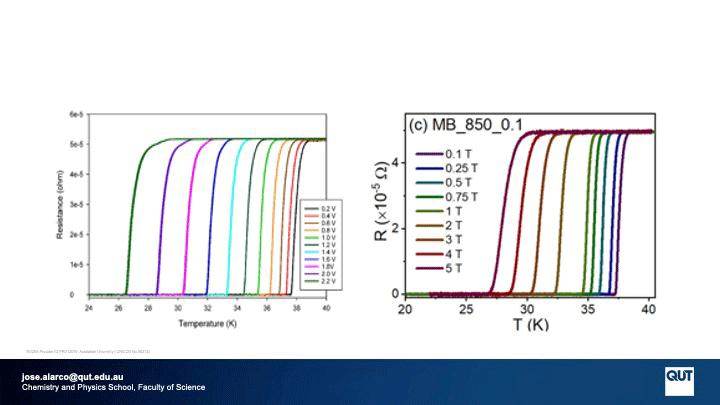PC-1-6
A generic DFT approach to identify and understand mechanisms and properties of layered superconductors
11:45-12:00 28/11/2023
*Jose A. Alarco1,2 , Mahboobeh Shahbazi1,2 and Ian D.R. Mackinnon2,3
1. Centre for Materials Science and School of Chemistry and Physics, Queensland University of Technology (QUT), QLD, 4001, Brisbane, Australia.
2. Centre for Clean Energy Technologies and Practices, QUT, QLD, 4001, Brisbane, Australia
3. School of Earth and Atmospheric Sciences, QUT, QLD, 4001, Brisbane, Australia
Inspired by Raman and synchrotron THz synchrotron absorption data that provide experimental evidence for superlattices [1-2], we analyse the implications of superlattice structures on the calculated electronic band structures and Fermi surfaces of selected layered superconductors [3]. Important phase relationships are identified within the band structures, highlighting the importance of bonding and anti-bonding character of the electronic bands along key symmetry and reciprocal space directions. Superlattice folding reveals an abundant amount of Fermi surface nesting between bonding and anti-bonding regions, not otherwise clearly identifiable [4]. In this way, superlattice symmetry is a better representation of atomic orbital symmetries [5-7]. We argue that these atomic orbital symmetries are more appropriate than atomic position symmetries to explain electronic properties including Cooper pairing mechanisms and superconductivity.
Flat bands near the Fermi level in calculated band structures have often been identified as key for superconductivity. We show that in addition to flat bands, cosine shaped bands corresponding to the transition from bonding to antibonding character near the Fermi level, are indicative of the superconducting gap and pairing mechanisms. Revised tight binding equations which accommodate slight modulations from pure cosine behaviour, allow for identification of the superconducting gap. We show that the magnitude of the gap can be extracted from standard electronic band structure calculations when determined with a sufficiently fine k-grid [8-9]. The gap is clearly correlated to the frequency of acoustic phonons balancing the conservation of energy at nesting conditions. Since electronic bands are frozen pictures of the equilibrium positions, we argue that electrons participating in nesting transitions invoke resonating phenomena where acoustic phonons are absorbed and desorbed. This behaviour maintains conservation of energy in a process described by an equation that resembles Cooper pairing.
Given the accuracy and reliability of our DFT results, particularly after experimental validation of calculation methods, we embarked on calculating the effects of external electric fields (or voltages) on the electronic band structures of selected superconductors [10]. The effect of an external field on the calculated band structure closely resembles effects previously identified on MgB2 bands for displaced B-B atom positions [11]. This outcome suggests that the superconducting transition temperature (Tc) should drop gradually with increased external field or voltage. Transition temperatures were experimentally measured on polycrystalline samples of MgB2 and gradual changes in Tc were confirmed. These changes display a strong resemblance to a Meissner effect measurement, suggesting a possible relationship between electric and magnetic fields. If we suppose that these fields are components of an electromagnetic wave, the ratio between the electric and magnetic fields, remarkably, provides a ratio in the THz range. These calculations also predict large electrostrictive effects, on the order of effects introduced by GPa levels of pressure. We propose that these externalities have great potential for additional practical applications of superconductors.
1. Alarco, J.A., Chou, A., Talbot, P.C. & Mackinnon, I.D.R., Phonon modes of MgB2: super-lattice structures and spectral response, Physical Chemistry Chemical Physics, 16, 24443-24456. (2014).
2. Alarco, J.A., Gupta, B., Shahbazi, M., Appadoo, D. & Mackinnon, I.D.R., THz/Far infrared synchrotron observations of superlattice frequencies in MgB2, Physical Chemistry Chemical Physics, 23, 23922-23932. (2021).
3. Alarco, J. A. & Mackinnon, I. D. R., Condensed Matter, 8, 72 (2023).
4. Grüner, G., Density Waves in Solids. CRC Press: Boca Raton, FL, USA, 1994. (1994).
5. Sutton, A.P. Electronic Structure of Materials. Clarendon Press, Oxford Science Publications: Oxford, UK. (2004).
6. Canadell, E.; Doublet, M.-L.; Iung, C. Orbital Approach to the Electronic Structure of Solids; Oxford University Press: Oxford, UK (2012).
7. Evarestov, R.A.; Smirnov, V.P. Site symmetry in Crystals: Theory and Applications; Springer Science & Business Media:Berlin/Heidelberg, Germany (2012).
8. Alarco, J.A., Almutairi, A. & Mackinnon, I.D.R., Progress Towards a Universal Approach for Prediction of the Superconducting Transition Temperature, Journal of Superconductivity and Novel Magnetism, 33, 2287–2292 (2020).
9. Mackinnon, I.D.R., Almutairi, A. & Alarco, J.A., Insights from systematic DFT calculations on superconductors, In Real Perspectives of Fourier Transforms and Current Developments in Superconductivity (Juan M.V. Arcos, ed.) Chapter 10, 1-29, IntechOpen Ltd., London UK. (2021).
10. Alarco, J.A., Shahbazi, M. & Mackinnon., IDR., Experimental control of Tc in AlB2-type compounds using an applied voltage. ArXiv Cond-Matter (2023).
https://doi.org/10.48550/arXiv.2204.00151
11. Alarco, J.A., P.C. Talbot, P.C.& Mackinnon, I.D.R. Electron Density Response to Phonon Dynamics in MgB2: An Indicator of Superconducting Properties” Modeling and Numerical Simulation of Materials Science, 8, 21-46 (2018).
The authors are grateful to the Central Analytical Research Facility (CARF), QUT, for access to laboratory facilities, to the e-Research Office, QUT, for access to high-performance computing facilities and assistance, and to the Australian Synchrotron, ANSTO, for access to the Far IR/THz beamline and expertise, through awarded beamtime.
